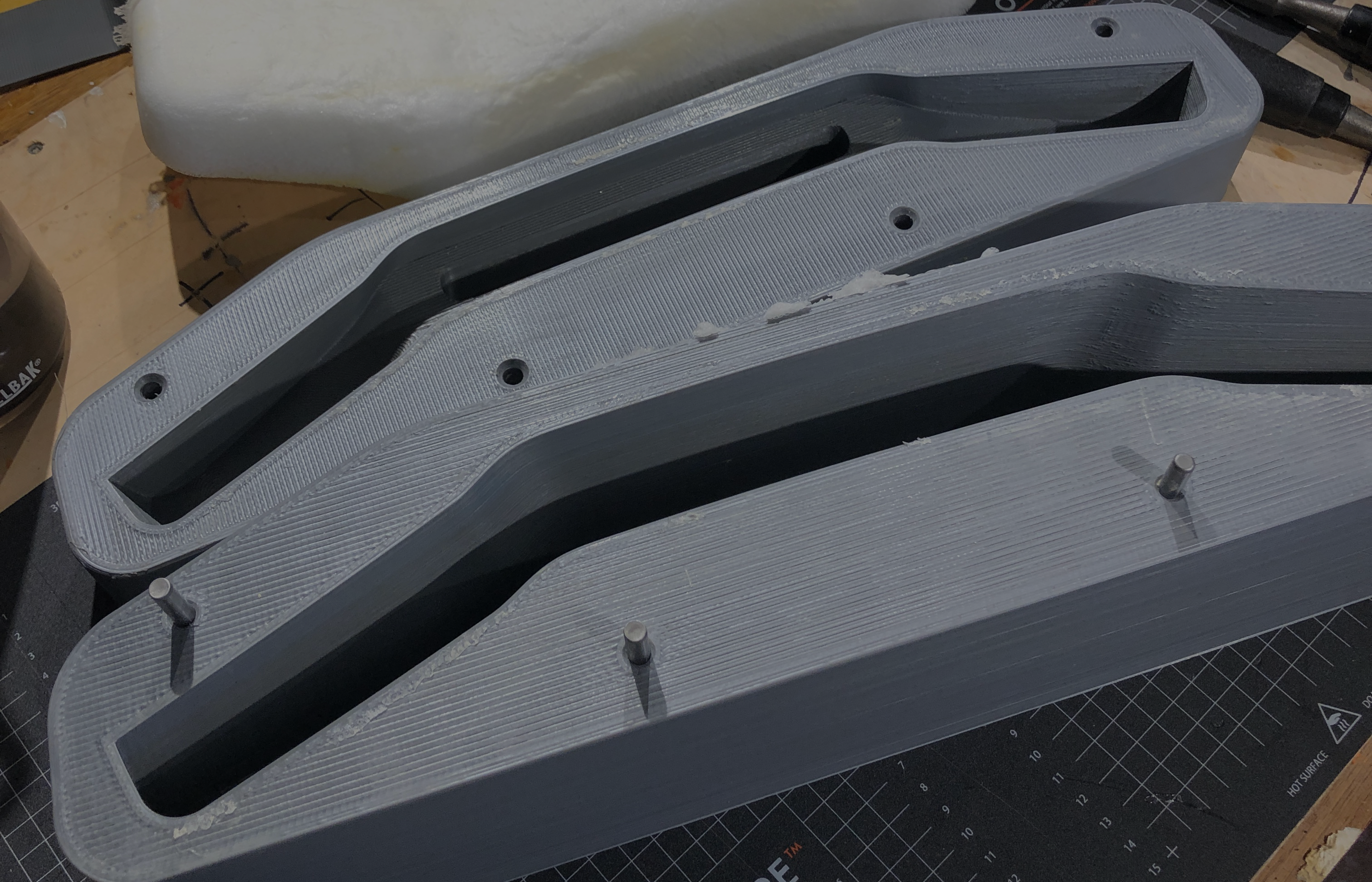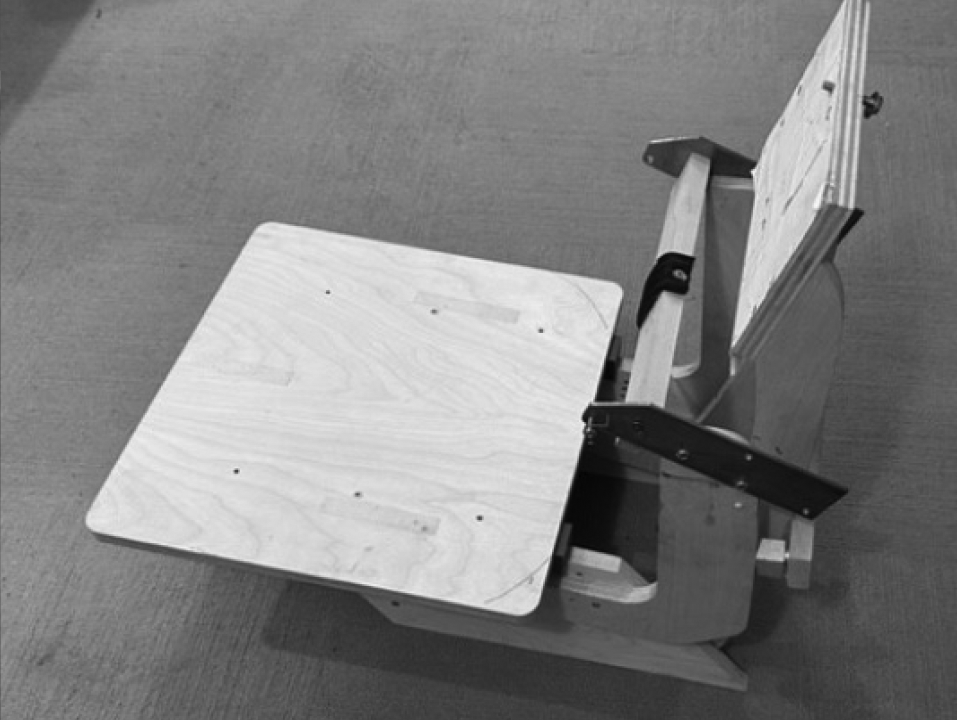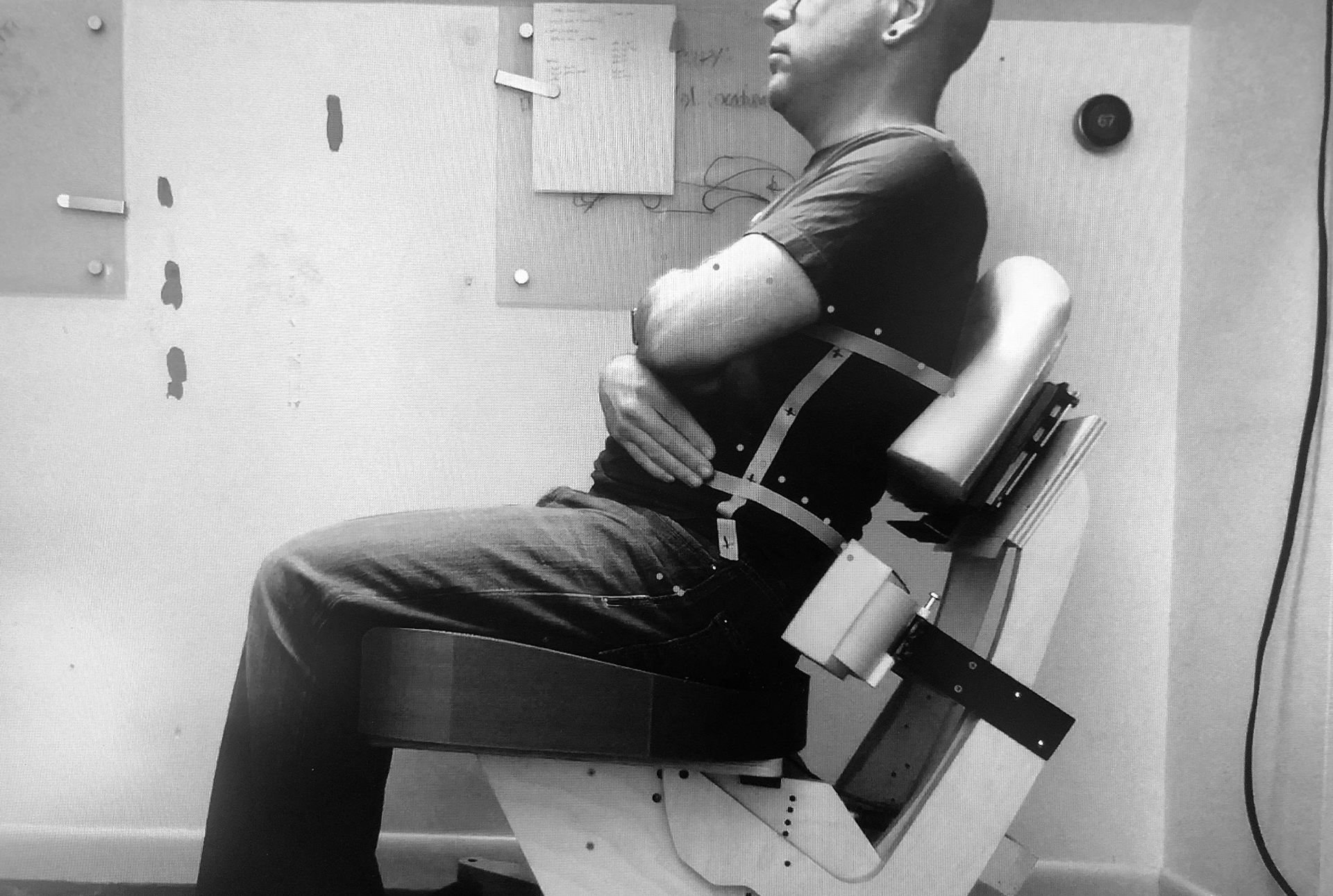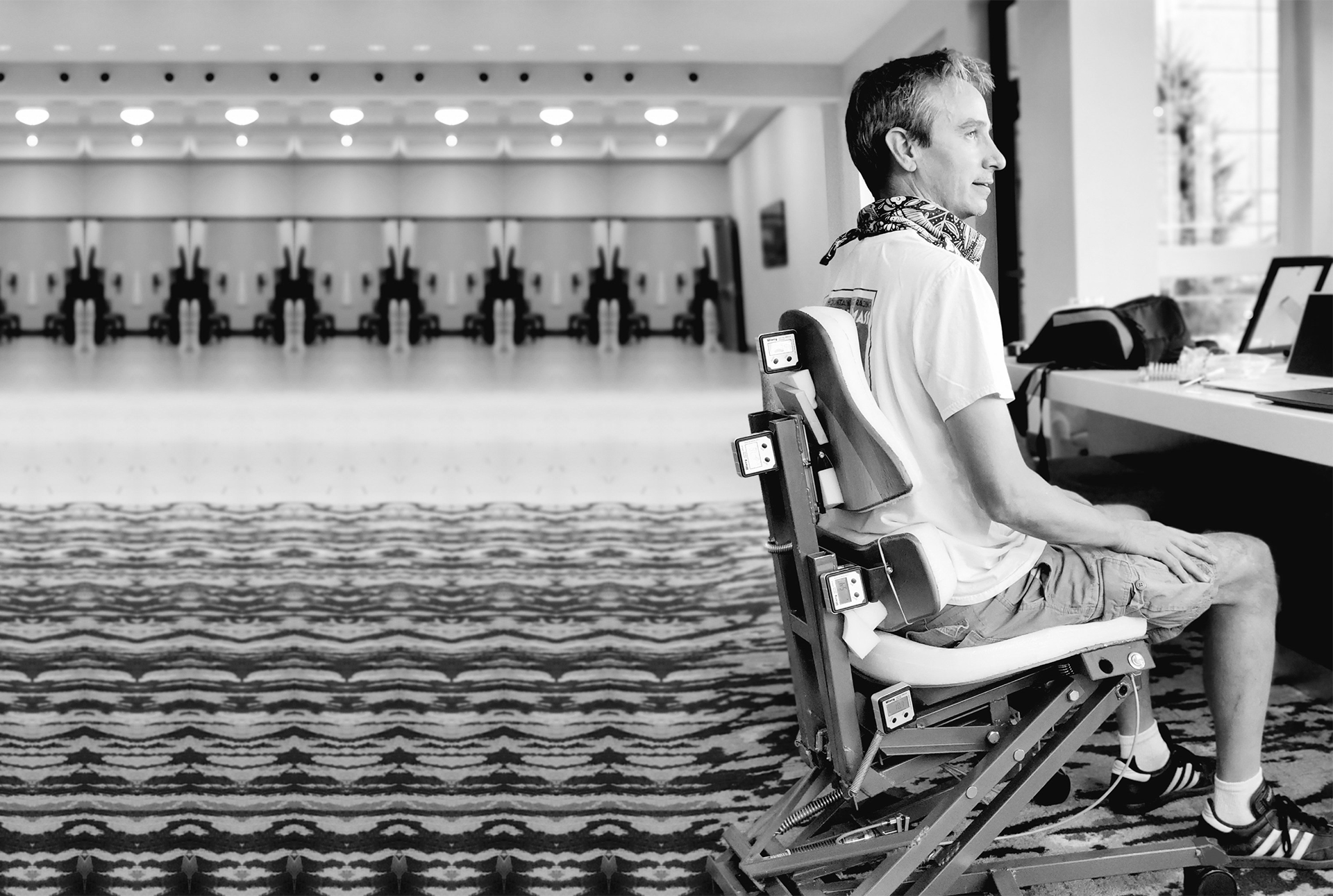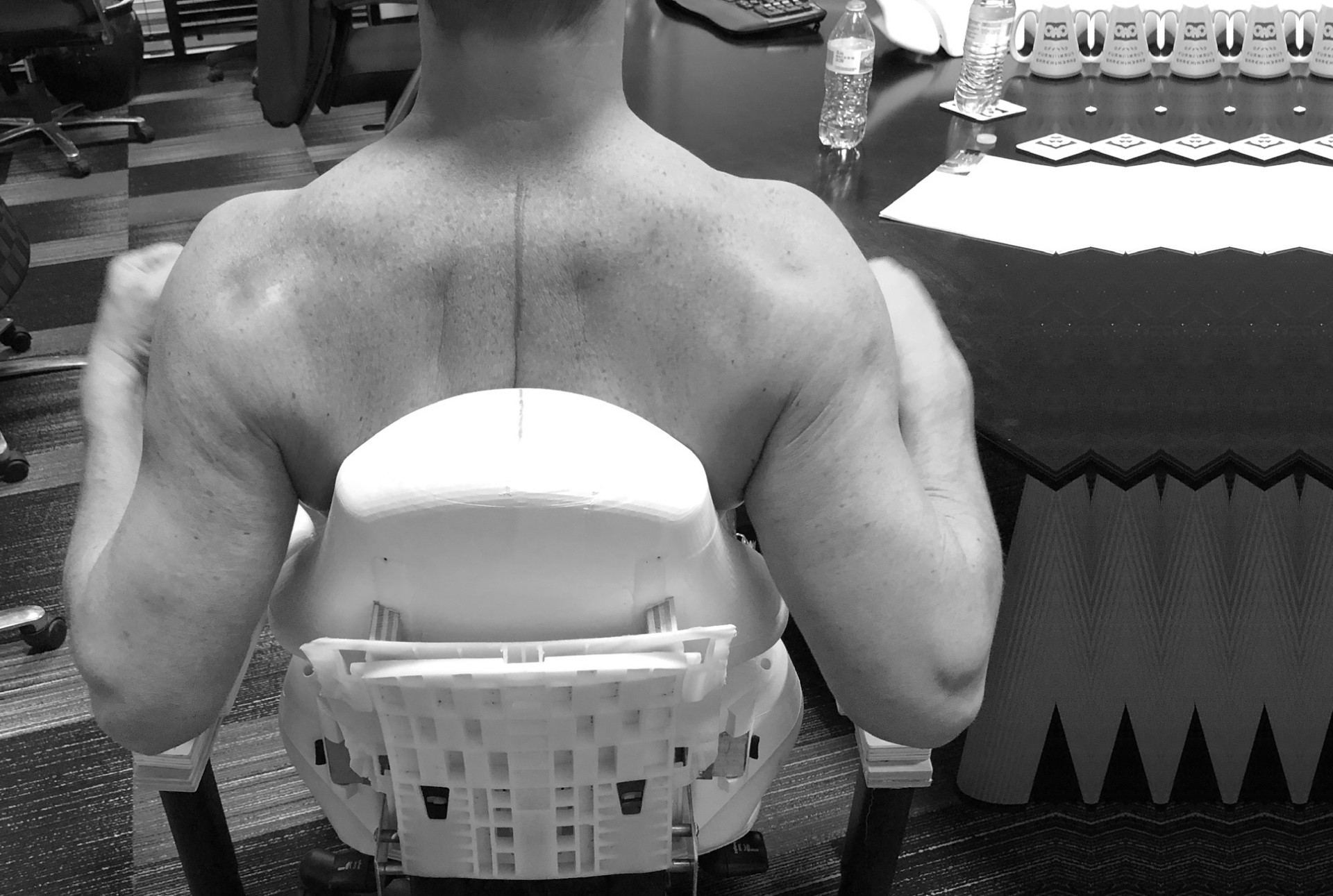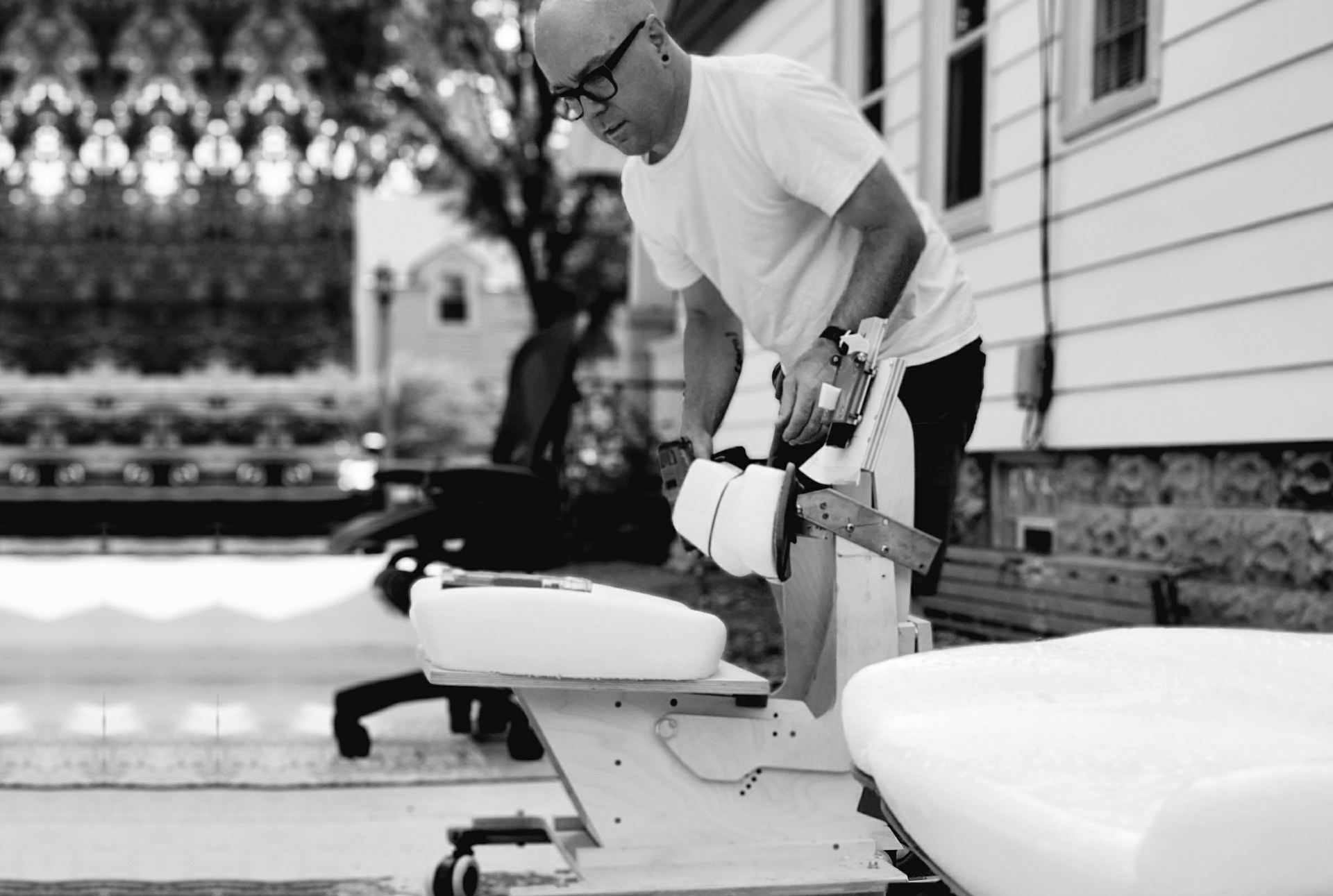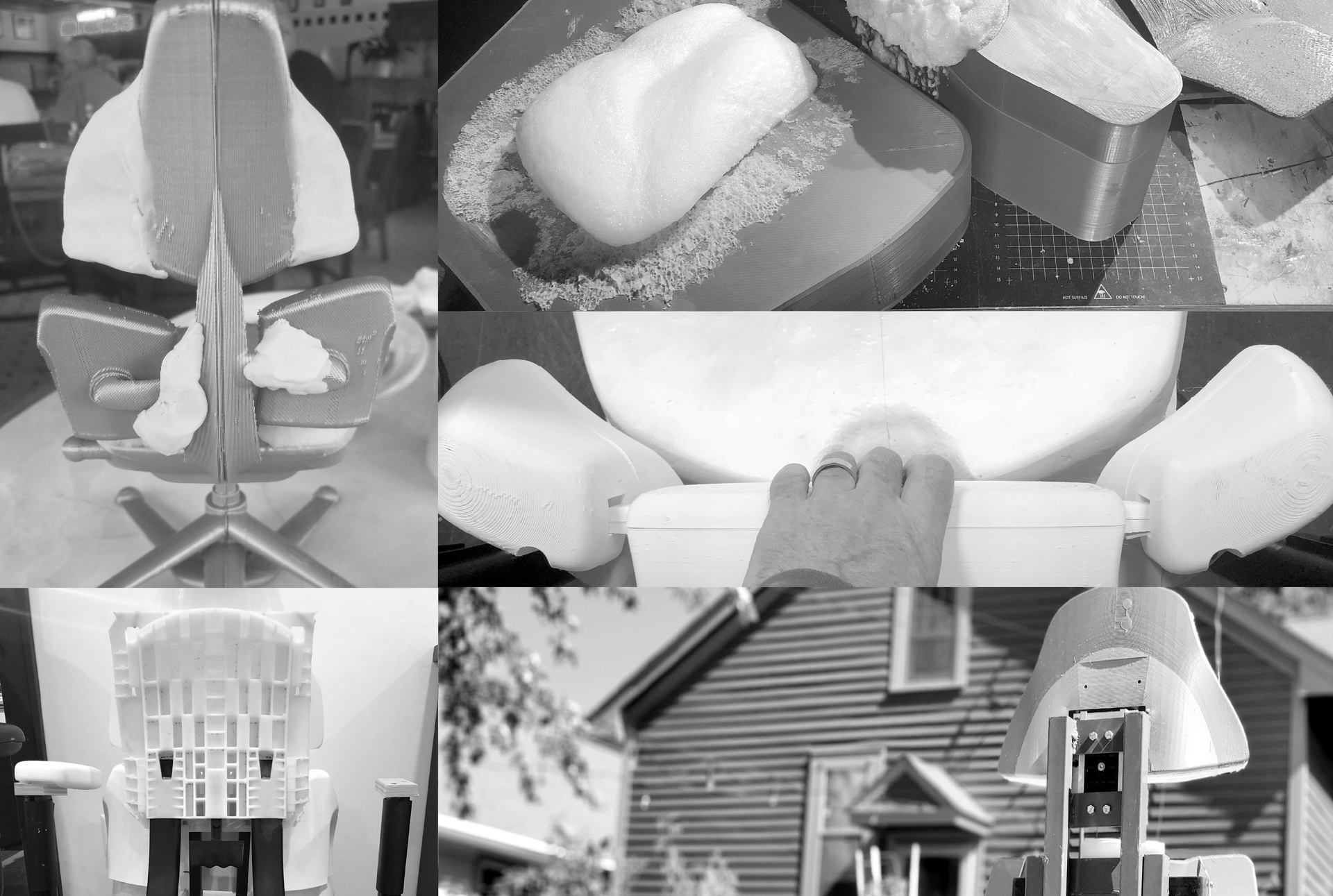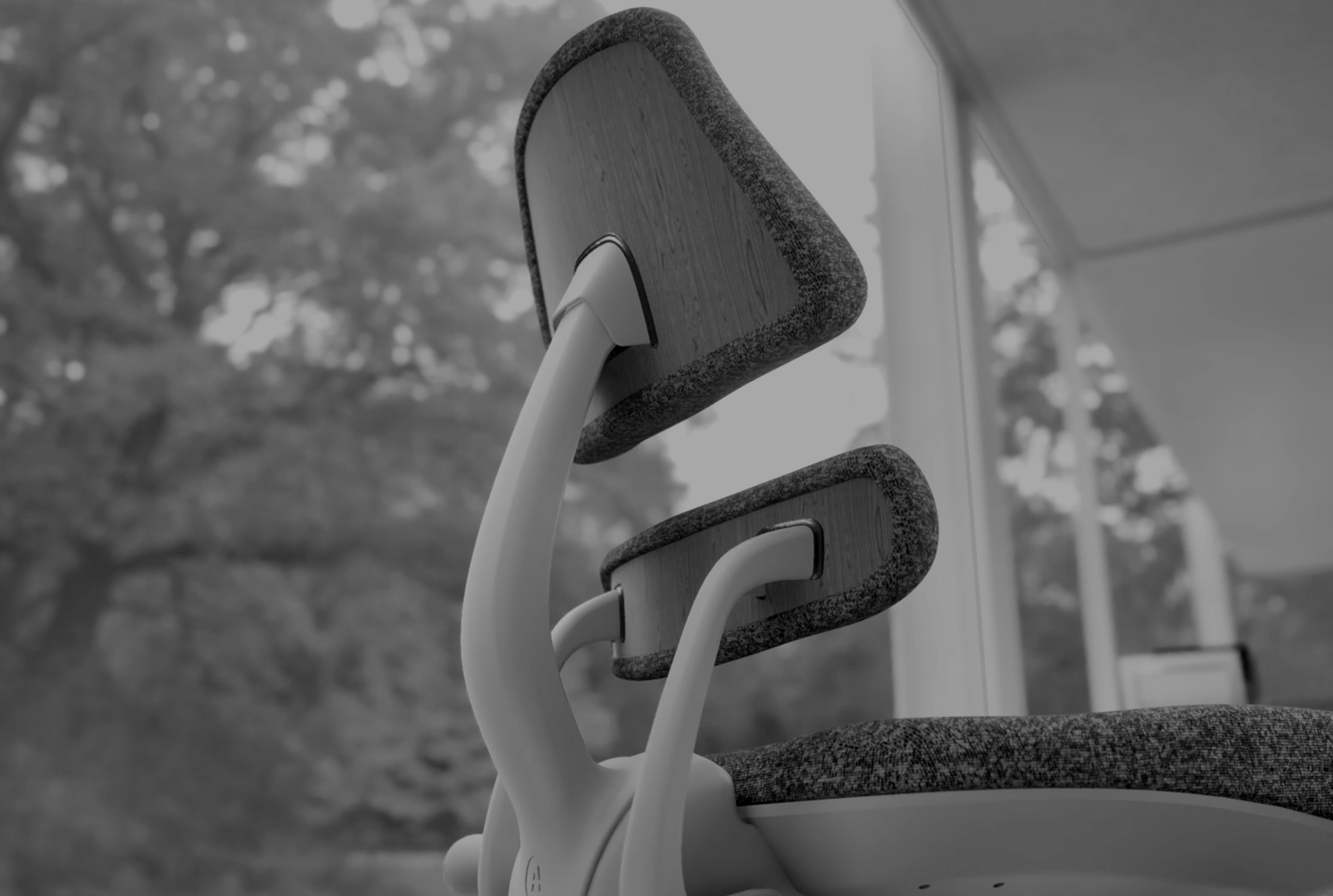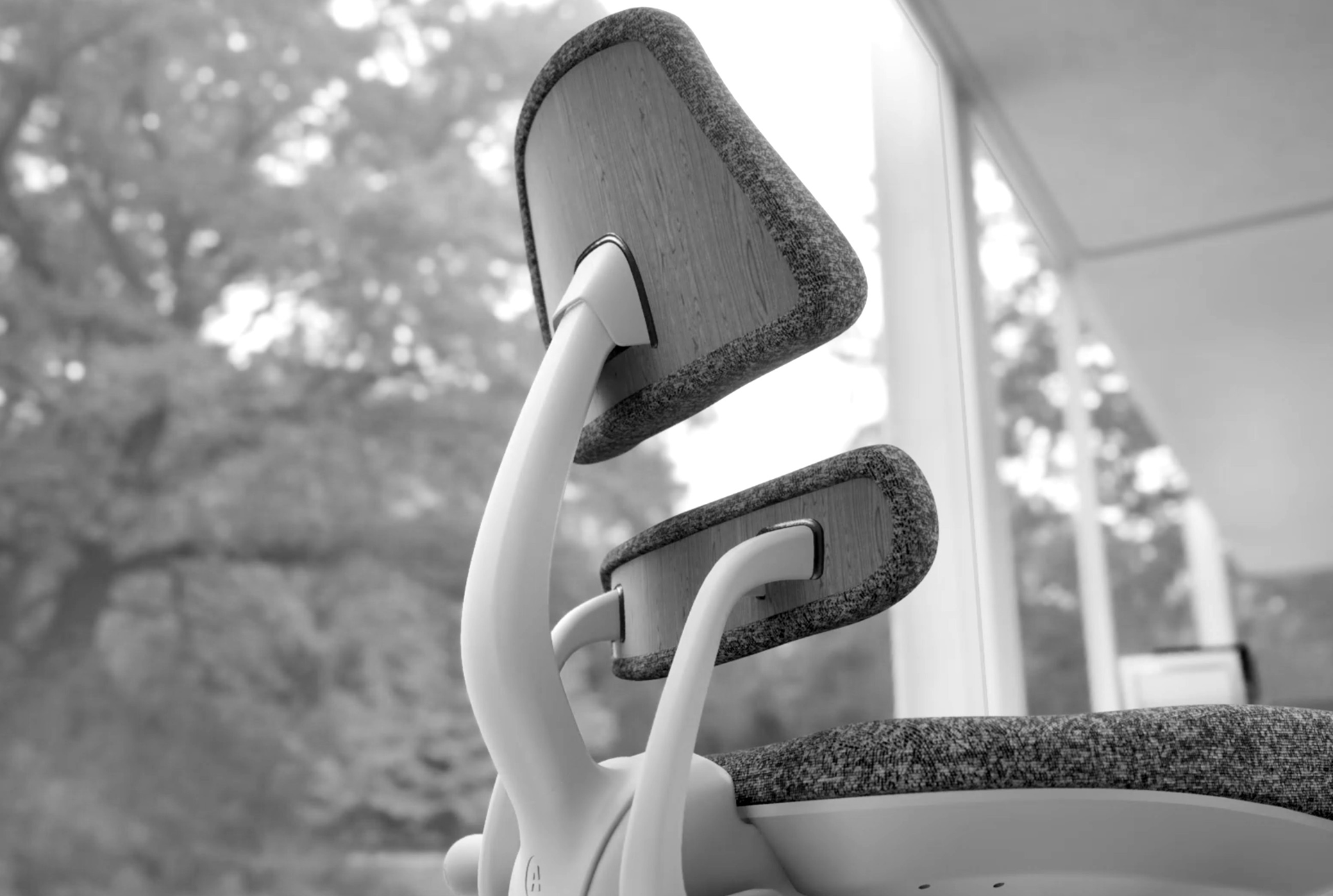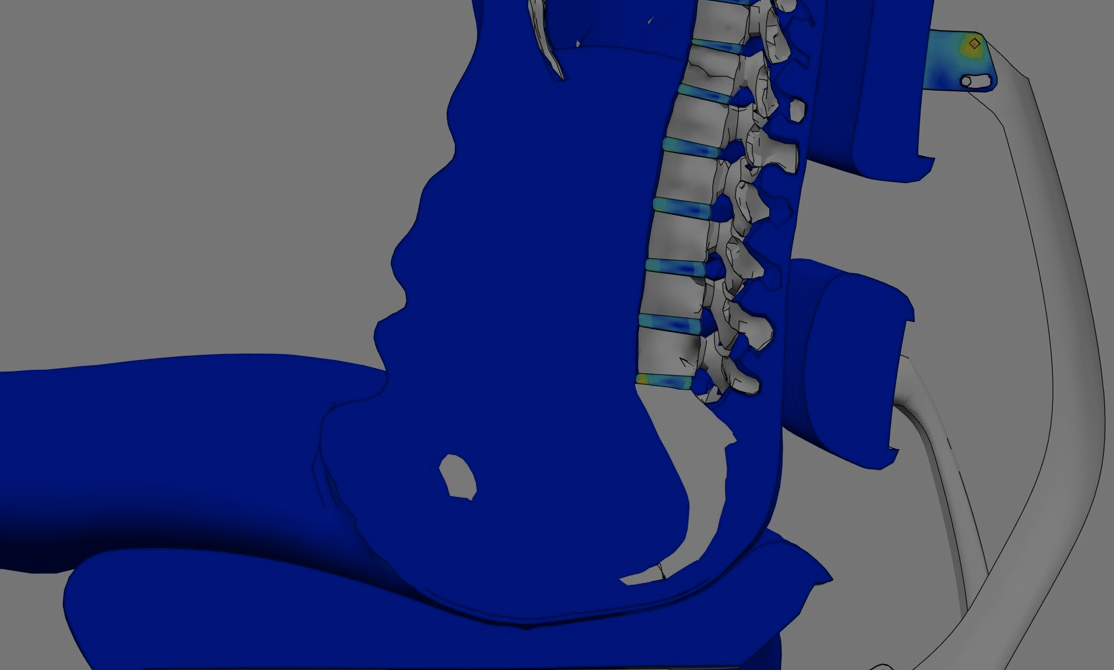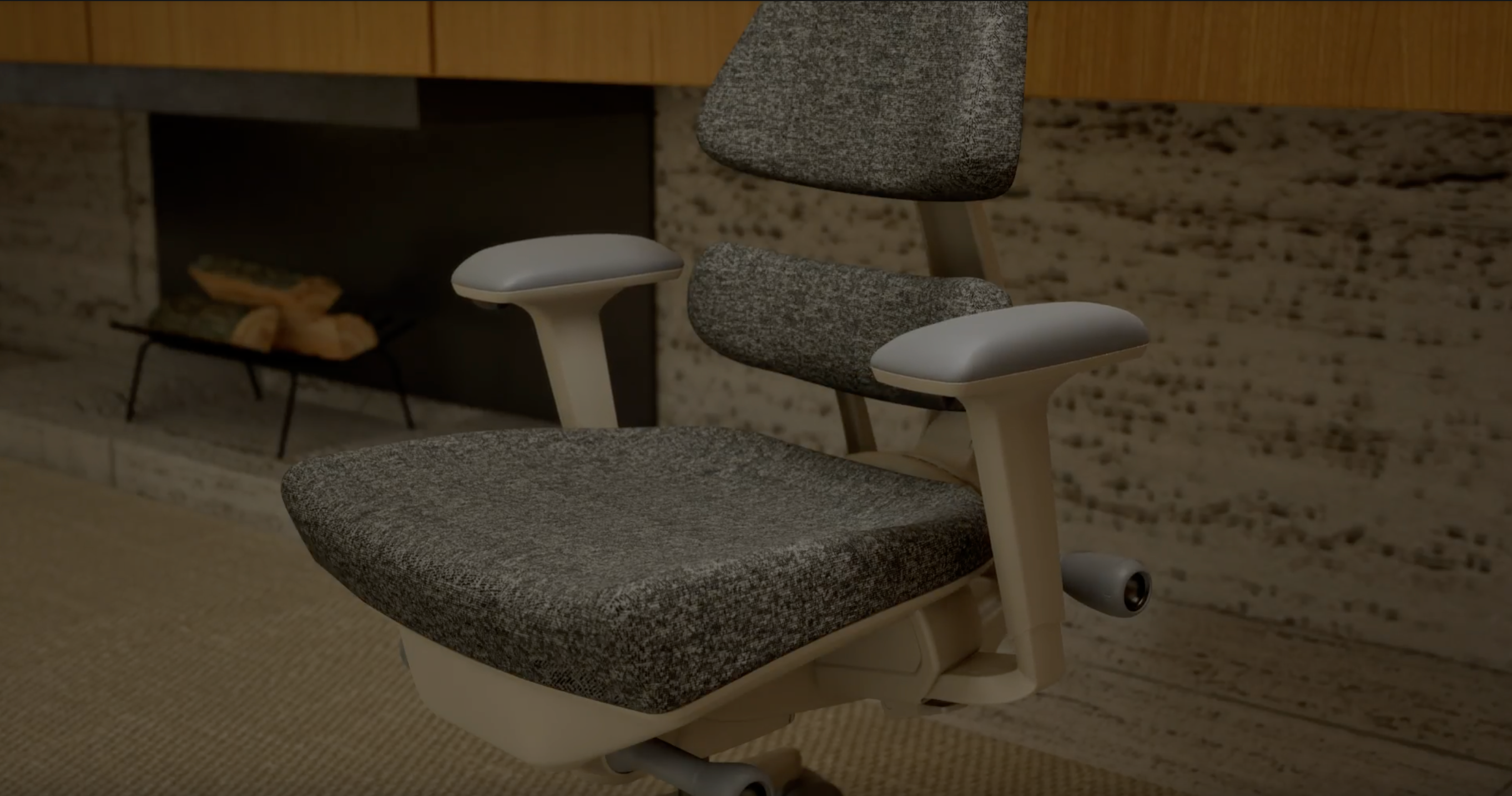THE ANTHROS SCIENCE STORY
The Anthros team is a group of medical professionals with 70+ years combined experience in the production and global distribution of high-quality wheelchair seating products. We conducted extensive research on the principles of human sitting and tissue needs, to create the most comfortable, posture-improving sitting products on the market. After years of hearing “I wish my office chair felt like this” the Anthros team set out to explore the science behind ergonomic office chairs.
THE SCIENTIFIC METHOD
1OBSERVATION
2 QUESTION
3 HYPOTHESIS
4 EXPERIMENT
5 ANALYSIS
6 CONCLUSION
OBSERVATION
PEOPLE ARE DISSATISFIED WITH CURRENT ERGONOMIC OFFICE CHAIRS
Do you ever hear people rave about how great their office chair is? Yeah, neither do we!
So we asked ourselves:
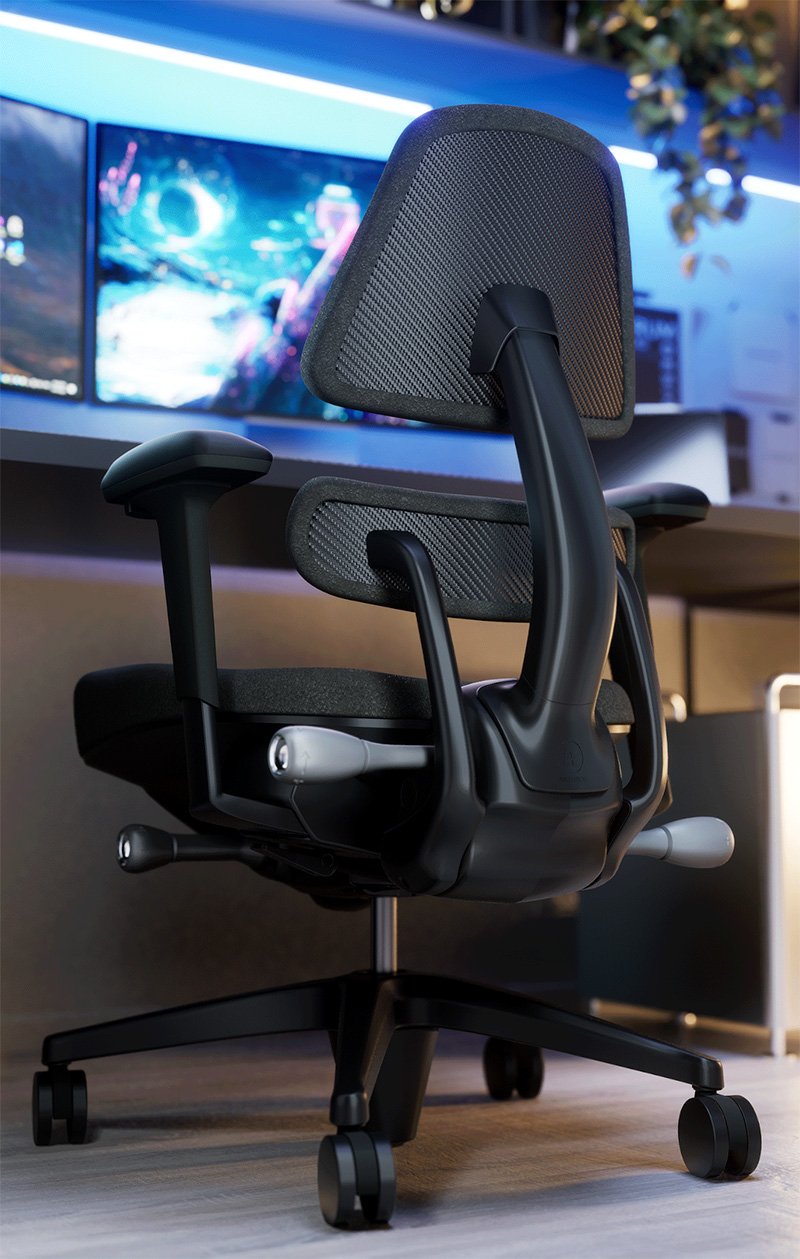
Join the Anthros family
Sign up to get special offers, the latest videos, news, + more!
*By signing up, I agree with the data protection policy of Anthros.
CHAIR, SPECIALIZED OR ERGONOMIC: HSA ELIGIBILITY
CHAIR, SPECIALIZED OR ERGONOMIC: REQUIRES A LETTER OF MEDICAL NECESSITY (LMN) TO BE ELIGIBLE WITH A HEALTH SAVINGS ACCOUNT (HSA)
A specialized or ergonomic chair for treatment of a medical condition may be eligible if accompanied with a Letter of Medical Necessity (LMN) with a flexible spending account (FSA), health savings account (HSA) or a health reimbursement arrangement (HRA).
HOW DO I USE MY HSA/FSA ACCOUNT TO PAY FOR MY ANTHROS CHAIR?
Since every insurance carrier is different, the process of using your HSA funds will vary.
Call your HSA Administrator to learn the process for your carrier.
Potential processes:
- Get a LMN from a medical professional (MD, PA, NP, Chiropractor)
- Use your HSA/FSA to purchase your Anthros chair online
- Submit your LMN to your HSA/FSA provider
- Get a LMN from a medical professional (MD, PA, NP, Chiropractor)
- Pay out of pocket for your Anthros chair
- Submit receipt and LMN to your provider
- Get reimbursed from your HSA/FSA funds
Have more questions?
QUESTION
CAN WE DESIGN THE WORLD'S BEST OFFICE CHAIR?
HYPOTHESES
- 1 Prove that we can create a back support that increases disc space and reduces disc pressure.
- 2 Prove that we can create a chair that is capable of improving your posture over time.
- 3 Prove that we can create the world’s most comfortable, lowest pressure cushion.
EXPERIMENT
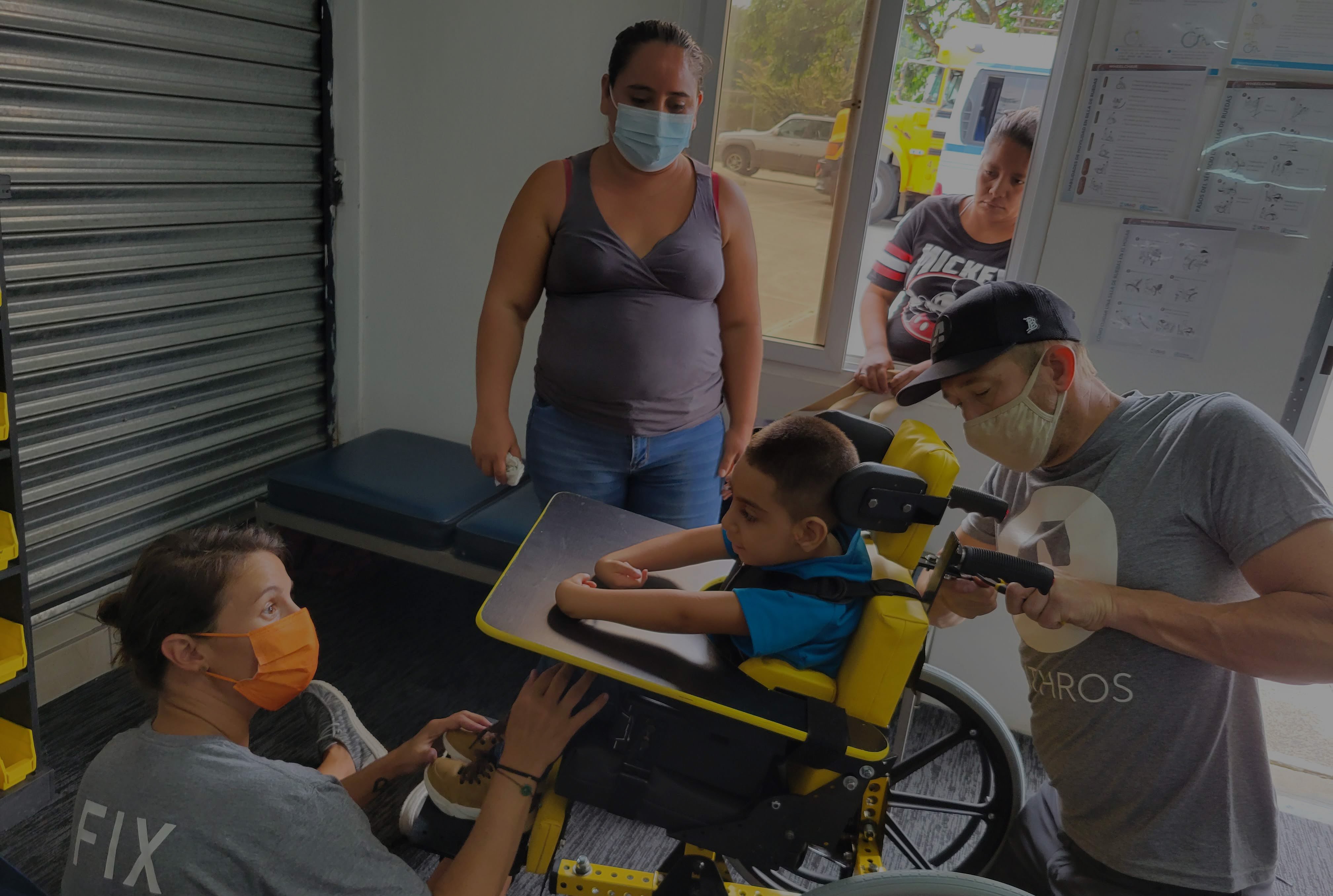
Seating Expertise
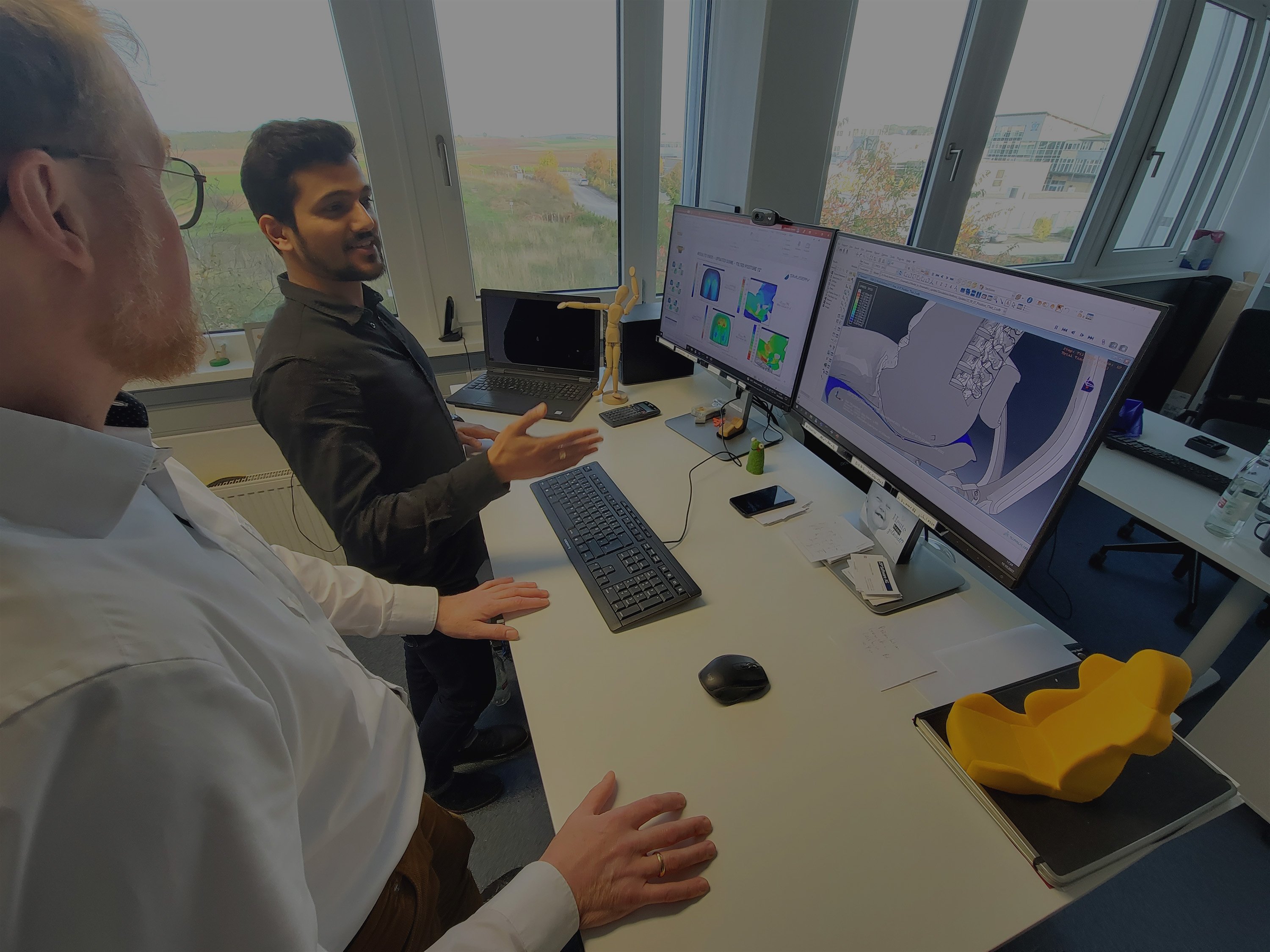
Digital 3D Human Modeling+ Simulation Software
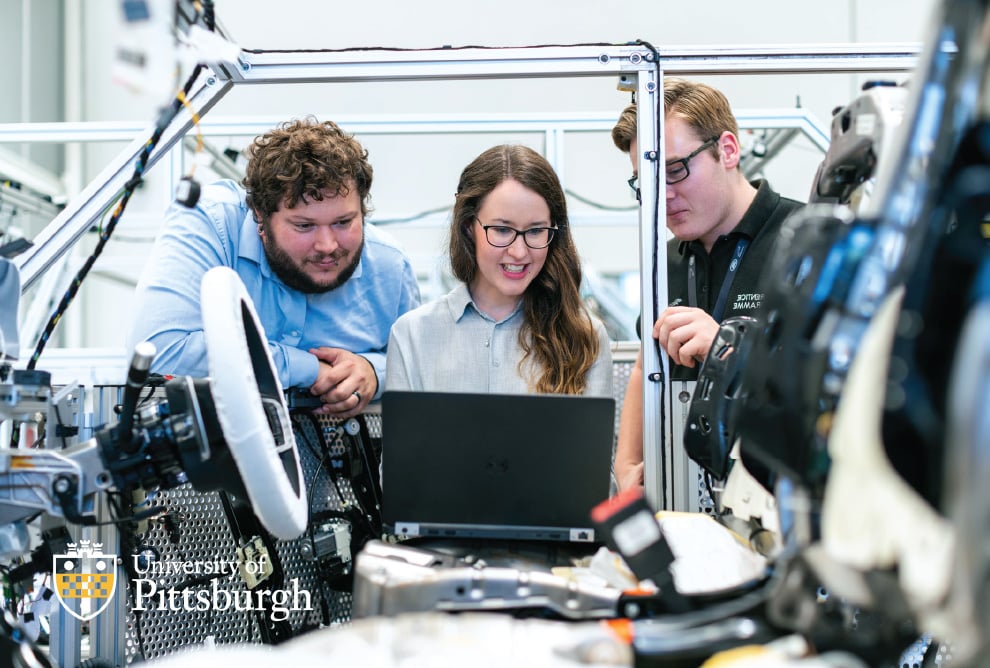
Medically-graded International Testing Standards

Submission to FDA as orthotic Device

Existing Data on the Science of Sitting

What We used to prove our hypotheses
EXPERIMENT
- Seating Expertise
- Digital 3D Human Modeling+ Simulation Software
- Medically-graded International Testing Standards
- Registered by the FDA as an orthotic device
- Existing Data on the Science of Sitting

Experiment
Based on decades of designing medical seating products for wheelchair users, Anthros imagined an independently adjustable two-part back system to better support and fit the vast differences in human bodies. It was designed using a meta analysis of sitting research and a deep understanding of sitting biomechanical principles.
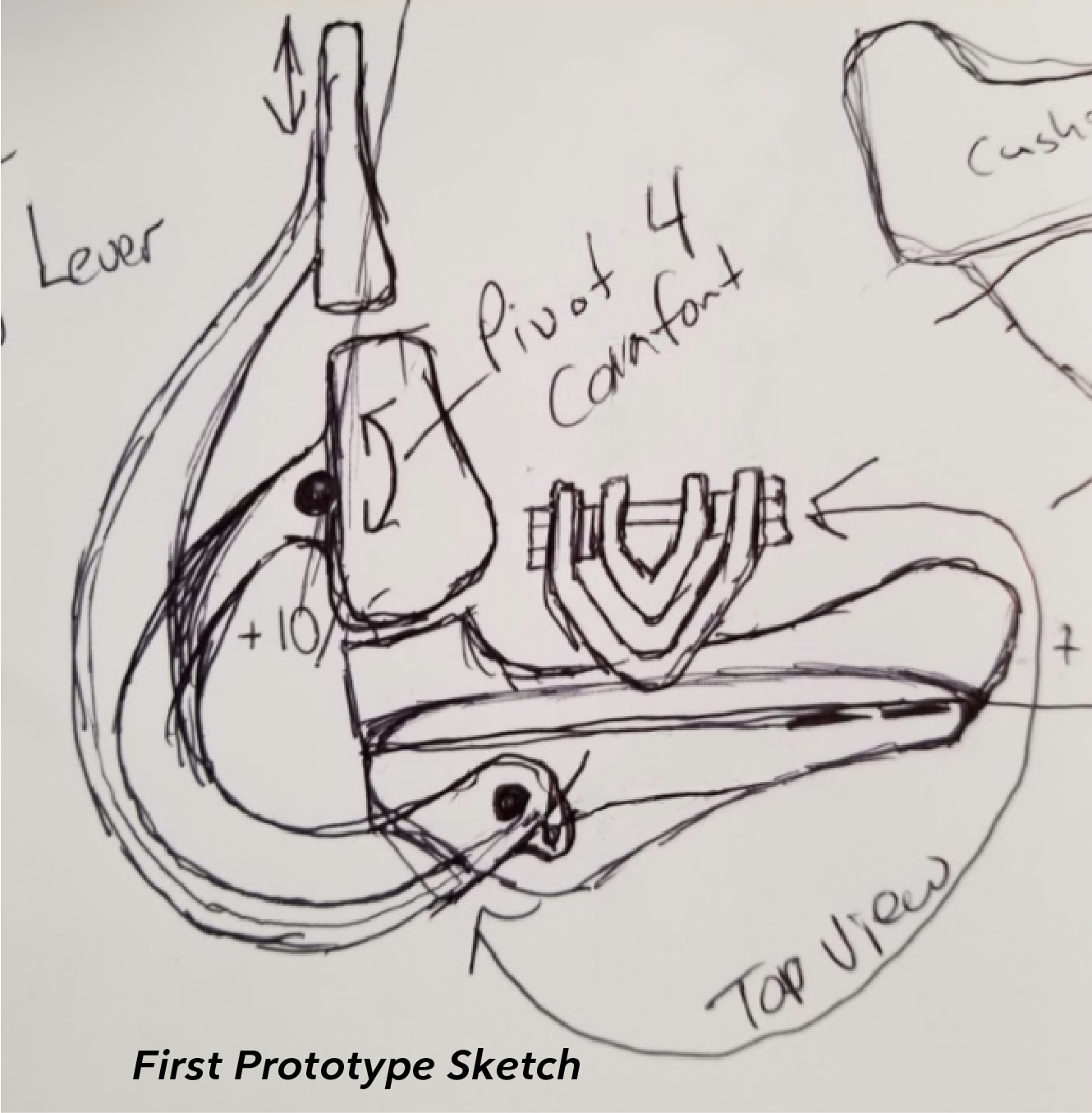

Experiment
Based on clinical research and decades of experience in medical seating design, we identified that aligning and supporting the pelvis, sacrum, and L4 and L5 regions is crucial for establishing a natural lumbar curve. This alignment promotes equal disc spacing throughout the spine. To achieve this, we used advanced 3D human modeling to validate and refine our two-part back design. After perfecting the design in a virtual environment, we created prototypes and tested them on human subjects of various shapes and sizes to confirm our findings.
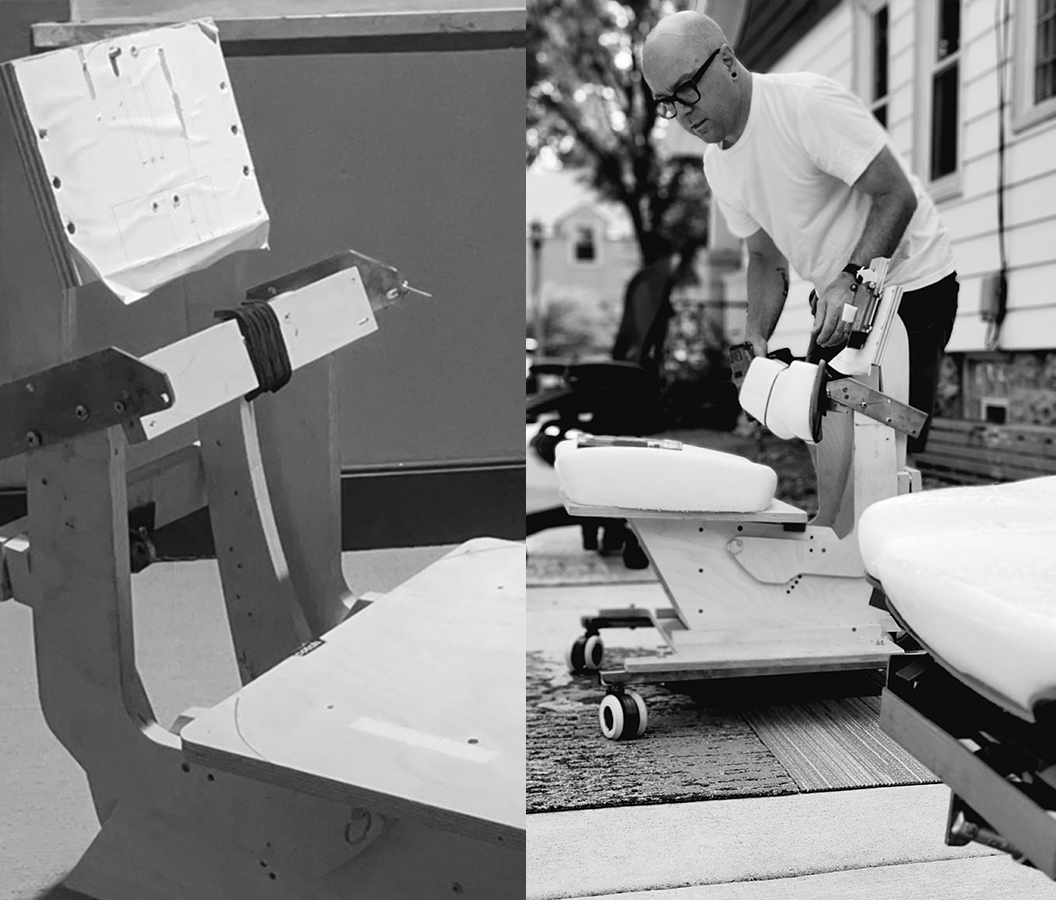

Experiment
Years of design iterations were dedicated to determining and optimizing the pivot points, movement patterns, and foam shapes of our two-part back system. This extensive work resulted in the development of the most natural human fitment available in any back seating system. It meets the diverse shapes, comfort, and support needs of our extensive panel of human test subjects.
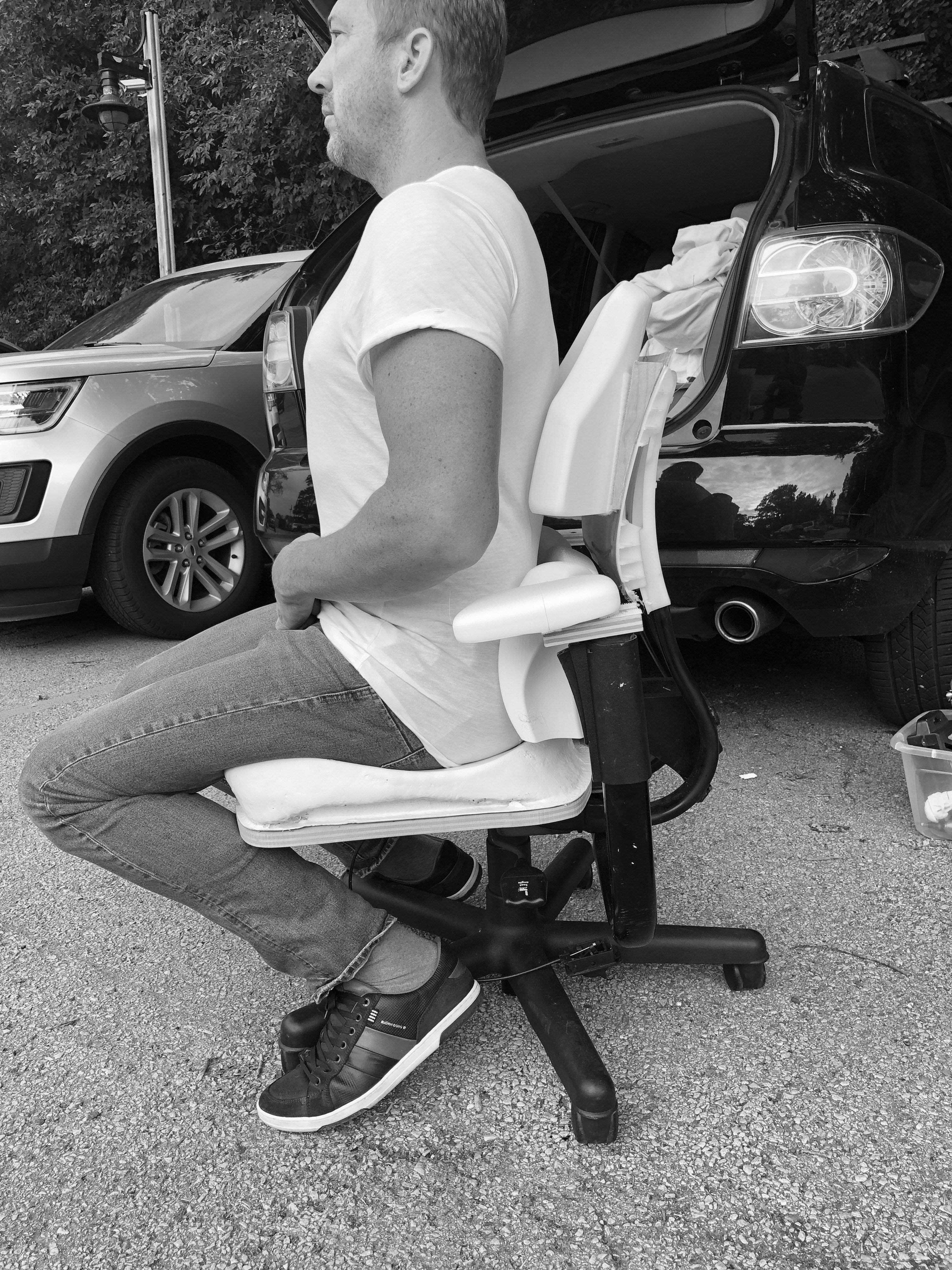
The effectiveness of this two-part back system was validated using 3D human modeling. Our testing was based on the Wilke et al. study, which examined intervertebral pressure in a live person in various positions. In their study, they used a pressure transducer inserted into the L4-5 disc.

Biomechanical and tissue modeling performed by Simuserv integrated by Abaqus Unified FEA from Dassault Systèmes
We leveraged cutting-edge 3D human modeling software and collaborated with the esteemed Simuserv Human Modeling team for all our human modeling design and analysis. Simuserv confirmed that disc pressure at L4-5 decreases with the properly adjusted Anthros two-part back system. Additionally, Simuserv observed a significant reduction in L4-5 disc pressures when our two-part back system was used alongside the Anthros tilt feature.

Analysis
The results of the Wilke study showed that an optimal disc pressure in neutral standing is 0.5 mpa.
With the 0.5 mpa value as optimal, we were pleased to see that our two-part back system could achieve and even surpass these values- Anthros in tilt shows a 40% decrease in disc pressure.
Markedly, Anthros in tilt shows a 57% decrease in disc pressure from standard office chairs.
| Standard Office Chair | Standing | Anthros Upright | Anthros Tilt |
|---|---|---|---|
| 0.7 mpa | 0.5 mpa | 0.5 mpa | 0.3 mpa |
| Standard Office Chair | Standing |
|---|---|
| 0.7 mpa | 0.5 mpa |
| Anthros Upright | Anthros Tilt |
| 0.5 mpa | 0.3 mpa |
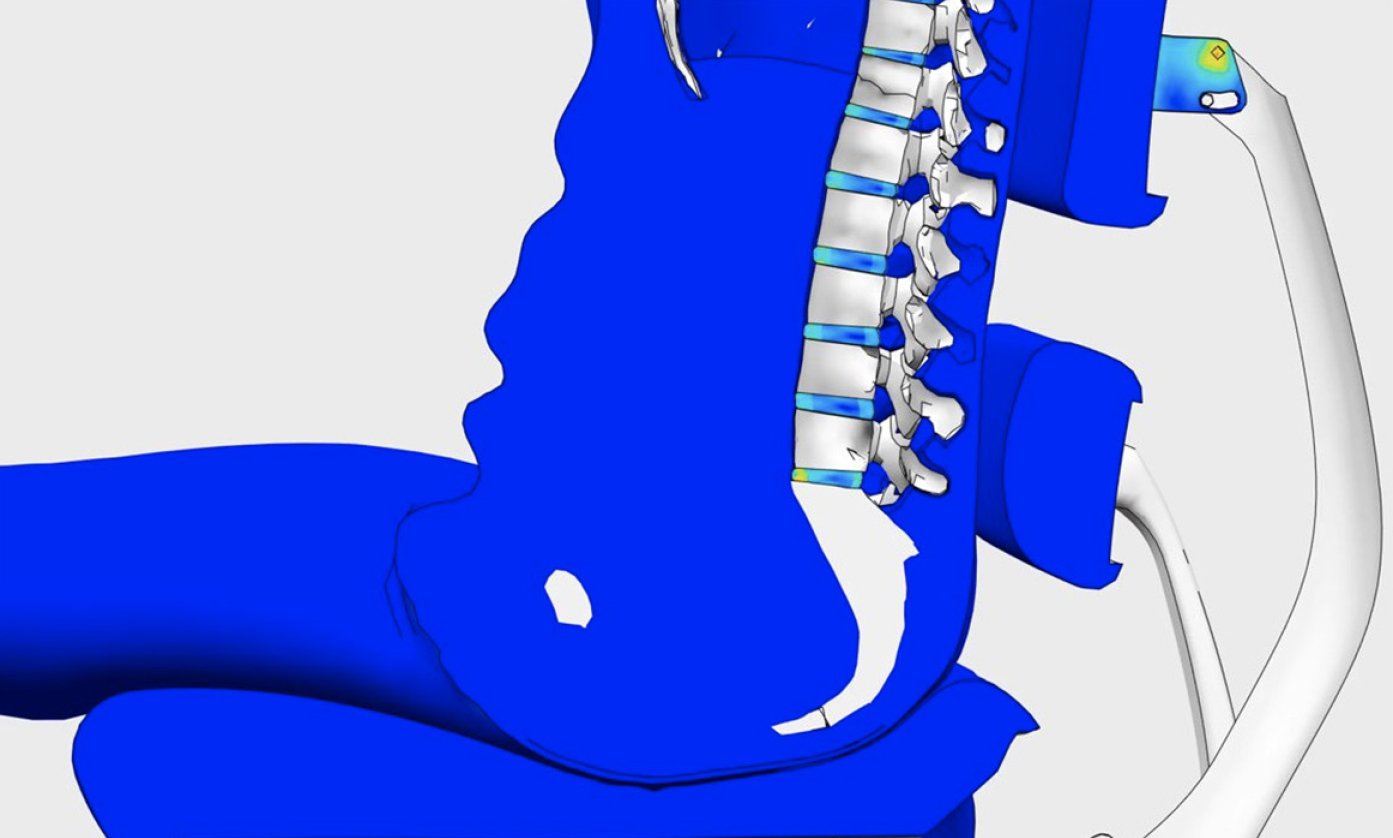
Experiment
Using 3D human modeling, we wanted to see the effect of supporting the pelvis independently in neutral. The goal was to see the spine follow into an “S” curve, which is a healthy anatomical posture for the intervertebral discs, vertebra, and nerve roots.
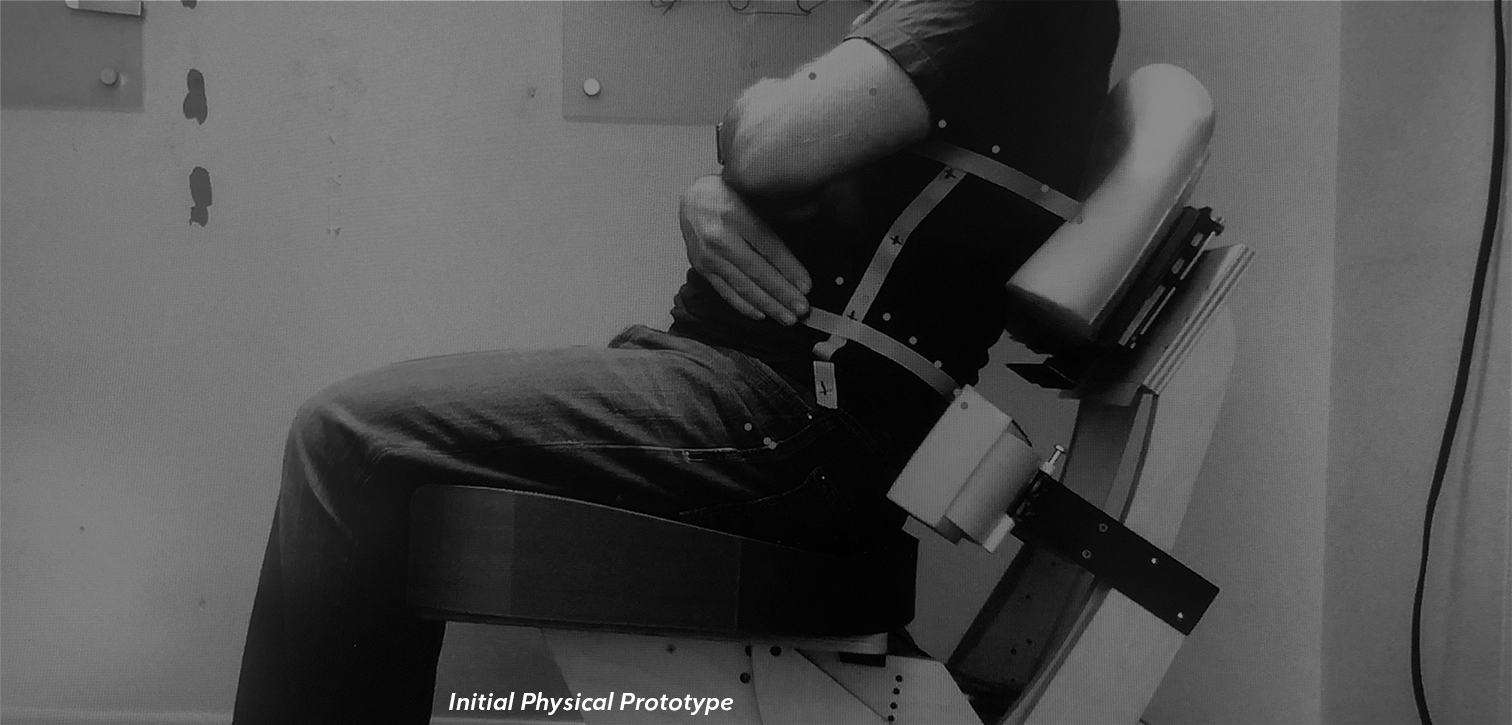
Analysis
Existing research shows that supporting the pelvis is the key to achieving and maintaining optimal spinal curves.
Existing research also shows that the body adapts to the position it is in most frequently. This means that sitting poorly all day will result in muscle imbalances and poor posture over time; whereas sitting well all day can help restore muscle balance and improve posture over time.
Conclusion
It can be clearly seen in the human modeling simulation that supporting the pelvis with the low back support resulted in the spine elongating and moving into an “S” curve. The upper back support acts to support the upper spine in this position. We can therefore infer, that sitting in the Anthros chair daily will position the body optimally and improve posture over time.
The FDA further validated our hypothesis by registering the Anthros chair as an orthotic device #3021484401, which is used to improve posture.
In legal terms: orthodic device means an apparatus used to support, align, prevent, or correct deformities, or to improve the function of movable parts of the body.

Experiment: Stages of design
With 70+ years designing wheelchair seat cushions, the knowledge and expertise of caring for the most vulnerable sitting population was brought to the Anthros seat cushion. The design began using anthropometric data, then 3D human simulation was used to adjust the design to achieve the lowest peak pressures possible. It began with contours to match the human shape, but we believed we could get lower pressures than we were seeing. We then created empty pressure relief cutouts in the area under the sit bones and saw a drastic reduction of peak pressures. These domes were then perfected in shape and size to ensure that different shapes and sizes of subjects would experience the same benefits.
2" Flat Foam
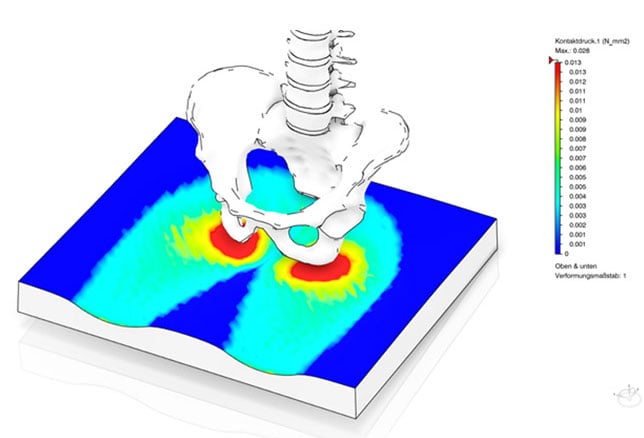
Contoured Foam
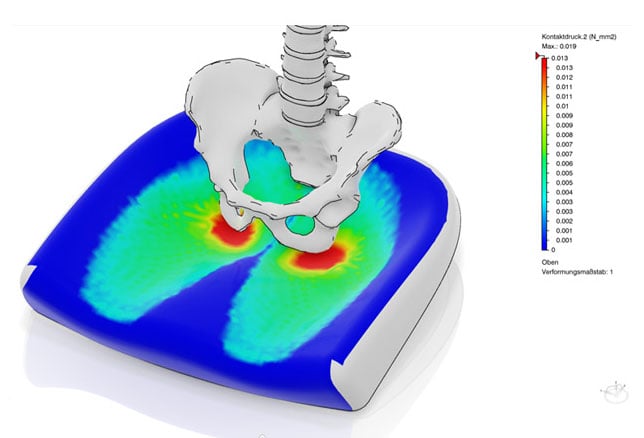
Contoured Foam with Pressure - Relieving Domes
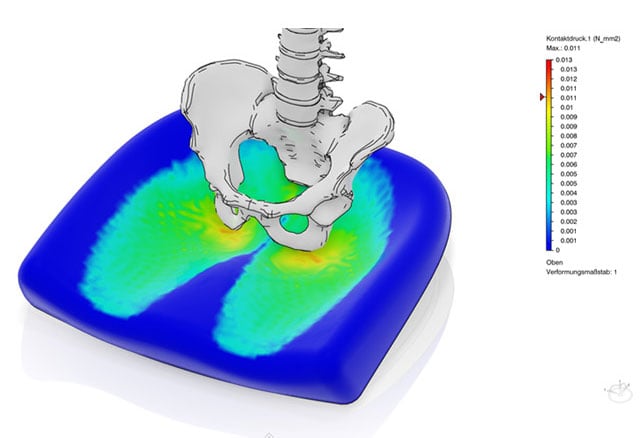

Experiment
Once we optimized the cushion design using 3D Human modeling to have the lowest sitting pressures (softness), we then validated the virtual design using real foam prototypes at an accredited university. The International Organization for Standardization (ISO) develops standards for all types of products, including wheelchair seat cushions. These standardized tests are established to evaluate how a product performs on measures that impact the user of the product. Anthros chose the University of Pittsburgh School of Health and Rehabilitation Sciences to perform the standardized bench tests on 11 office chair seats to evaluate performance, considering most people sit in these seats for at least 8hrs per day. Since the walking population primarily uses office chairs we focused on the most relatable measure of comfort: average peak sitting pressures.
*Performed on 4/5/25 at the University of Pittsburgh with a rigid load indenter. Human results may vary.
SHEAR Shear is the combination of downward pressure (in sitting, through the buttocks), and horizontal friction (sliding forward in your seat when your skin sticks to the seat and you feel that pull). Imagine a child sliding down a metal slide wearing a bathing suit, with skin sticking to the slide all the way down; this is shear.
CONTACT AREA Contact area represents how much contact the indenter (or person) is making with the seat surface. A higher contact area is desired as it implies greater pressure distribution and lower peak pressures.
= Comfort
PEAK PRESSURE INDEX
Peak pressure implies high pressures in one area. The peak pressure index is what is calculated by averaging the individual sensor results along the simulated IT (sit bones) portion of the testing fixture. Rather than simply taking the single highest value as the peak pressure, one random reading won’t skew the results or the perception of performance. A high peak pressure index is associated with discomfort or pain, so low values are desired.
Analysis
The results of the independent university testing clearly show that the Anthros seat cushion outperforms all other office and gaming chair seat cushions tested.
Peak Pressure Index
This test will record the sitting pressure your body will make with the various seat designs. Think park bench versus a large down feather pillow.
Peak Pressure Index
University of Pittsburgh Study
Low Values are Desirable
- 40
- 80
- 120
- 160
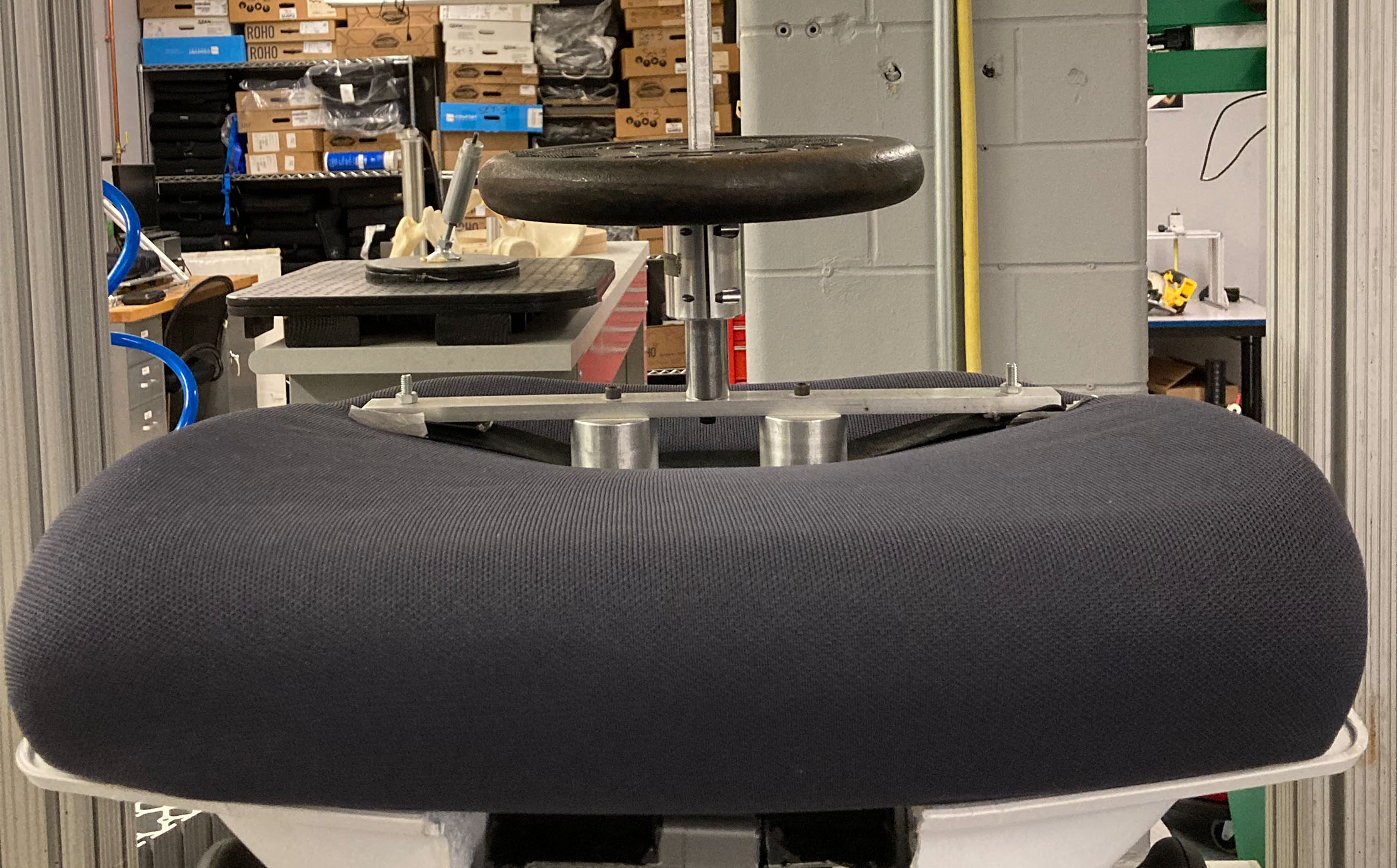
Conclusion
Independent university testing proves that Anthros outperforms industry-leading office chairs in the most common measure of comfort. Anthros has created the most comfortable sitting experience with the lowest peak pressures.
DON’T JUST TAKE OUR WORD FOR IT
SEE WHAT SIMUSERV MANAGING DIRECTOR ALEXANDER SIEFERT HAS TO SAY ABOUT ANTHROS
CONCLUSION
SUMMARY
After years of experiments, collecting data, and existing research, we found we COULD:
- 1 Prove that we can create a back support that increases disc space and reduces disc pressure
- 2 Prove that we can create a chair that improves posture
- 3 Prove that we can create the world’s most comfortable, lowest pressure cushion
CAN WE DESIGN THE WORLD’S BEST OFFICE CHAIR? SCIENCE SAYS YES!
Customize Yours NowDISC SPACE Zhang, L., Helander, M. G., & Drury, C. G. (1996). Identifying factors of comfort and discomfort in sitting. Human Factors, 38(3), 377–389. https://doi.org/10.1518/001872096778701962
Underwood MR, The Use of a Back Teaching Class teaching extension exercises in the treatment of acute low back pain in primary care, Oxford Univ, Great Britain, 1998) (Kreutz, D. (1997). Power tilt, recline or both. Team Rehab Report ,March. 29 – 31.
SUPPORTING THE PELVIS Cohn, 1886; Schoberth, 1969; Branton, 1969; Lee, 2010
Lee H, Yoo W. The mechanical effect of anterior pelvic tilt taping on slump sitting by seated workers. Industrial Health 2011, 49, 403-409.
O’Sullivan P, Dankaerts W, Burnett A, et al. Lumbopelvic kinematics and trunk muscle activity during sitting on stable and unstable surfaces. Journal of Orthopaedic & Sports Physical Therapy 2006b;36(1):19e25
O’Sullivan P, Dankaerts W, Burnett A, et al. Lumbopelvic kinematics and trunk muscle activity during sitting on stable and unstable surfaces. Journal of Orthopaedic & Sports Physical Therapy 2006b;36(1):19e25
Tanoue H, Mitsuhashi T, Sako S, Goto R, Nakai T, Inaba R. Effects of a dynamic chair on pelvic mobility, fatigue, and work efficiency during work performed while sitting: a comparison of dynamic sitting and static sitting. J Phys Ther Sci. 2016 Jun;28(6):1759-63. doi: 10.1589/jpts.28.1759. Epub 2016 Jun 28. PMID: 27390410; PMCID: PMC4932051.
IVD PRESSURE AS IT RELATES TO COMFORT Zhang, L., Helander, M. G., & Drury, C. G. (1996). Identifying factors of comfort and discomfort in sitting. Human Factors, 38(3), 377–389. https://doi.org/10.1518/001872096778701962
Underwood MR, The Use of a Back Teaching Class teaching extension exercises in the treatment of acute low back pain in primary care, Oxford Univ, Great Britain, 1998) (Kreutz, D. (1997). Power tilt, recline or both. Team Rehab Report ,March. 29 – 31.
BODY ADAPTS TO POSTURE OVER TIME Katsman et al. Age-Related Hyperkyphosis: Its Causes, Consequences, and Management. J Orthop Sports Phys Ther. 2010 Jun; 40(6): 352–360.
Kim D, Cho M, Park Y, Yang Y. Effect of an exercise program for posture correction on musculoskeletal pain. J Phys Ther Sci. 2015;27(6):1791-1794. doi:10.1589/jpts.27.1791
Burgess-Limerick, R., A. Plooy, and D. Ankrum, The effect of imposed and self-selected computer monitor height on posture and gaze angle. Clinical Biomechanics, 1998. 13(8): p.584-592.
Info
Join our email list
Sign up to get special offers, the latest videos, news, + more.





